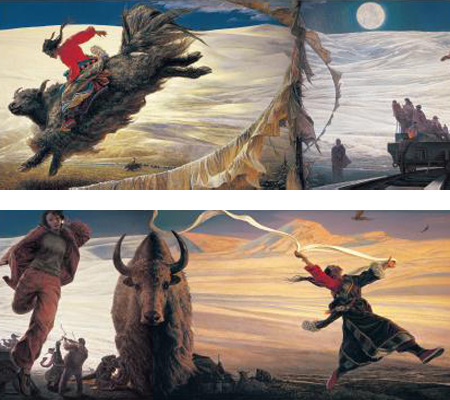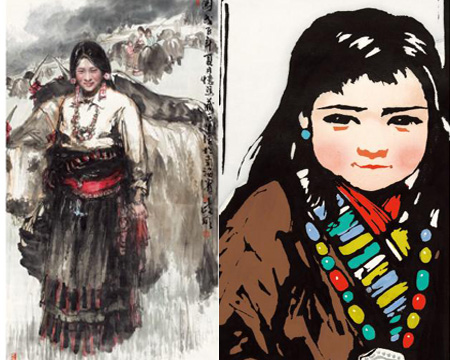
A painting titled Run to Lhasa exhibited in Italy following the conclusion of the Second Forum on the Development in China's Tibet held in Rome from Oct. 22 to Oct. 23, 2009. (Photo Source People's Daily online)
Foreign diplomat visitors in Italy indicated Tuesday that inspired by the painting exhibition on Tibet being held in Rome, they were looking forward to visiting the snowy plateau if possible.
Featuring masterpieces created during the 1952-2009 period by 68 famous Chinese Han and Tibetan painters, the exhibition has displayed Tibet's splendid landscapes, diverse cultural relics and Tibetans' daily life in various art forms including Chinese brush painting, oil painting, woodcut, and fabric painting.
While visiting the exhibition, Attilio Massimo Lannucci, director-general of the Asia-Oceania Department of the Italian Foreign Ministry, applaud the exhibition again and again in Chinese hen hao, hen hao (very good).
Speaking of the difference in understanding the Tibet issue between China and the West, Lannucci said Western media always make reports at their own will. It's true that exchanges between China and Western countries have been not sufficient. Italians do not have a good knowledge of China and Chinese still lack a deep understanding of Italy… That's why it is necessary to promote mutual exchanges this way.

Photo shows two paintings on Tibet exhibited in Italy after the conclusion of the Second Forum on the Development in China's Tibet held in Rome from Oct. 22 to Oct. 23, 2009. (Photo Source People's Daily online)
Wu Changjiang, vice chairman of the Chinese Fine Arts Association, said the exhibition was warmly received in Italy, because these paintings need not explaining. Visitors will find what they're interested in and share their ideas with one another through pictures. As a result, misunderstanding and barriers will be gone this way.
One of the greatest changes that have taken place in the past decades in Tibet is that the Tibetan ethnic group has achieved synchronous development with other ethnic groups in the world. The greatest change is the emancipation of human ideology and the growth of culture, said Tibetan artist Nyimar Tsering, who was granted the title of the painter for the 10th Panchen Lama.
For instance, paintings in the past on the plateau were almost Tangka (the Tibetan art of scroll painting,) whose development depended on the religion. In the 1980s, we Tibetan painters began to express our innermost feelings with Tibetan artistic features. It takes 500 years of renaissance for Italy to usher in the era of art development in Europe, but it takes only 20 years for us Tibetans to usher in the era of artistic development, he added.
